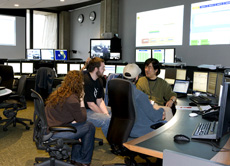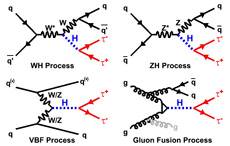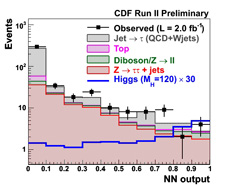|
Thursday, May 29
1 p.m.
Physics and Detector Seminar - West Wing WH-10NW
Speaker: T. Barklow, Stanford Linear Accelerator Center
Title: Understanding the Requirements for Jet Energy Resolution
Speaker: T. Rizzo, Stanford Linear Accelerator Center
Title: Jet Energy Studies at 1 TeV
2:30 p.m.
Theoretical Physics Seminar - Curia II
Speaker: H. Lee, University of Florida
Title: Proton and Dark Matter Without R Parity
3:30 p.m.
DIRECTOR'S COFFEE BREAK - 2nd Flr X-Over
4 p.m.
Accelerator Physics and Technology Seminar - One West
Speaker: T. Peterson, Fermilab
Title: Cryogenics for Warm Physicists and Engineers
Friday, May 30
3:30 p.m.
DIRECTOR'S COFFEE BREAK - 2nd Flr X-Over
4 p.m.
Joint Experimental-Theoretical Physics Seminar - One West
Speaker: C. Henderson, Massachusetts Institute of Technology
Title: Global Search for New Physics with 2 inverse femtobarns at CDF
Click here for NALCAL,
a weekly calendar with links to additional information.
|
|
Thursday, May 28
- Minnesota wild rice w/chicken
- Tuna melt on nine grain
- Italian meatloaf
- Chicken casserole
- Vegetarian salad wrap
- Assorted slice pizza
- Mandarin chicken
*Carb restricted alternative
Wilson Hall Cafe menu |
|
Thursday, May 29
Dinner
- Closed
Wednesday, June 4
Lunch
- Salad nicoise with fresh grilled tuna
- Lemon cheese cake
Chez Leon menu
Call x4598 to make your reservation. |
|
|
CMS remote operations
gear up at Fermilab

The CMS hadron calorimeter group had a large presence in the ROC
during the cosmic run.
The seven hour time difference between Batavia, Illinois, and Geneva, Switzerland, can make scheduling difficult. For remote operations, however, the time difference has advantages.
U.S. CMS collaborators recently used the Remote Operations Center at Fermilab to take over some of the overnight shifts at CERN during a test run of the detector earlier this month.
This was the first time that CMS had around-the-clock shifts since the detector went underground. "It takes a lot of manpower to have around-the-clock shifts," said U.S. CMS Remote Operations Coordinator Kaori Maeshima. "We set up a tradition for Fermilab to help."
During the week-long test, called a cosmic run, CMS collected roughly 30 million cosmic-ray events. Cosmic runs give collaborators a chance to test out the detector. The data collected allows scientists to better understand the detector problems that they may encounter when real data-taking begins.
The data helps scientists optimize the experiment's sub-detector systems, such as the hadron calorimeter. The HCAL group, which has a large number of U.S. members, used the ROC during the cosmic run to completely cover the sub-detector's owl shift at CERN during the cosmic run. "We read out signals from all the sub-detector channels and got a lot of important data," said Shuichi Kunori of the University of Maryland, who coordinates the HCAL remote shifts at Fermilab.
Fast data transfer between CERN and the US CMS Tier 1 computing center at Fermilab made remote operations possible. "It is great to see real data arrive so promptly at the ROC," said Taylan Yetkin, a physicist at the University of Iowa.
The CMS collaboration plans to have another cosmic run in June.
-- Elizabeth Clements
|
Comic strip pokes fun at letter



This User Friendly comic strip references a symmetry breaking story included in the May 20 issue of Fermilab Today about a cryptic letter. Although little progress was made in breaking the code, it did generate some interest, such as the comic strips above. The comic strip story line continued until May 24.
|
Physicist led cancer program
From Chicago Tribune, May 28, 2008
Dr. Arlene J. Lennox, a medical physicist, worked tirelessly to help treat cancer patients at what is now the Northern Illinois University Institute for Neutron Therapy at Fermilab.
Since 1983, Dr. Lennox, who recently retired as technical director, helped hundreds of patients who had cancer that did not respond to most treatments. Neutrons can be more effective at killing tumors than conventional radiation therapy.
"Although she did not start the facility, she became one of the world's experts on neutron therapy and certainly important to keeping the program going here at the lab."
Dr. Lennox, 65, of Elburn, died of metastatic breast cancer Saturday, May 24, in her home.
It was her responsibility to calibrate machines and ensure the treatment plan prescribed by patients' doctors.
Also, she was chief administrator of the program and staff, said Thomas Kroc, who replaced Dr. Lennox. "She was a tremendous asset in neutron therapy," Kroc said.
Read more
|
Weather throws rare factor into research
From symmetry breaking, May 27, 2008
Fermilab employees like rare events. They search for rare interactions of particles and attempt to create rare particles such as the theorized Higgs boson.
But sometimes, even for Fermilab employees, enough is enough.
Fermilab always has been a magnet for severe weather. The laboratory sits near a tornado-prone swath of Illinois and its 6800 acres of prairie and mostly low-level buildings offer little to slow or divert high winds.
Employees practice for tornadoes, and take the weather in stride, but last year, a series of rare weather occurrences-a winter tornado and a straight line of wind storms-struck near Fermilab reminding employees that the uncertainty principle doesn't just work in physics. Anything not forbidden by a quantum rule that can happen will happen. So be ready.
In April, Chicago icon television meteorologist Tom Skilling (photo above) and several National Weather Service experts from regional offices throughout the nation converged on Fermilab for a talk to more than 3000 weather buffs.
Read more
|
|
|
Taking the tau road

Signal Feynman diagrams simultaneously searched for in this analysis. If the Higgs boson exists, all four processes would appear in the same final state (2 taus s + 2 jets).
One of the most hotly-pursued particles in physics today is the Higgs boson, which may give mass to all elementary particles. CDF scientists recently performed the first dedicated search in the tau lepton mode for the Higgs, using events with two taus and two jets.
This search enabled scientists to make a 10 percent improvement in the overall CDF sensitivity, equal to a 20 percent increase in luminosity, to help pinpoint the mass of the Higgs boson.
To search for the famed particle, CDF physicists first modeled and carefully estimated the backgrounds. Then they employed an artificial neural network technique to further improve the sensitivity.
Experiments at CERN's LEP collider and Fermilab's Tevatron indicate that the Higgs mass should be between 114 GeV/c2 and 160 GeV/c2, less than the top quark mass.
If the Higgs mass is in the lower part of this region, less than approximately 135 GeV/c2, then it should decay into two bottom quarks (H -> bb) and two tau leptons (H -> ττ) 70-80 percent and 7-8 percent of the time, respectively. Thus, it is not surprising that enormous effort has gone into searches in the bottom quark mode.
The main contributing Feyman diagrams to the H->ττ search channel, which include every way the Standard Model Higgs particle is produced at the Tevatron, are shown in the above graphic. By designing a search sensitive to every production mechanism, we make 56 more potential Higgs events in two inverse femtobarns of CDF data.
Painstaking improvements like this are essential to overcoming the great obstacles to unlocking nature's secrets. This final state is one of LHC's primary Higgs discovery modes.
The Tevatron's experience in identifying taus and handling background is extremely valuable to the LHC, providing an essential Tevatron-LHC connection for the exciting journey to the eventual Higgs discovery.
Learn more

Neural Net output distribution comparing the data to the predictions. The Higgs signal (times 30) is shown in the blue line. There is no significant excess in the signal region.
 |
Kohei Yorita and Young-Kee Kim, from the University of Chicago. |
Result of the Week Archive
|
|
Have a safe day!
New Perspectives Conference June 3
The 2008 Annual New Perspectives Conference will take place on June 3 in
conjunction with the Users' Meeting. The one-day conference offers talks
given by and geared towards undergraduate, graduate and post-doctoral
physicists. The conference includes a poster session. Please click
here for more information.
Users' meeting June 4-5
Fermilab will host the annual Users' meeting on Wednesday, June 4, and Thursday, June 5. For more information or to register, visit the Users' Meeting Web site.
Accelerated C++: A Short Course in Practical Programming by Example
On June 2, Fermilab will offer the first session of Accelerated C++: A Short Course in Practical Programming by Example.
The Short Course is an extended professional development experience that emphasizes computer programming in modern standard C++. No tuition is charged; the only cost is for the required textbooks. (A subsidy is available for most students.) Participants receive TRAIN credit upon successful completion of the eight-session course. Course registration is now open.
Heart risk screening June 3, 10
Wellness Works and Delnor-Community Hospital will offer a heart risk screening on Tuesday, June 3, and Tuesday, June 10. The assessment will take place by scheduled appointment between 6:30 a.m. and 10:45 a.m. for Fermilab employees in the EOC on the ground floor of Wilson Hall. Those interested can sign up on the ES&H Web page. Participants must fast for 12 hours but can drink water.
June 6 deadline for The University of Chicago Tuition Remission Program
The deadline for applying for the tuition remission program at The University of Chicago for the Summer 2008 quarter is June 6. For more information and enrollment forms, contact Nicole Gee at x3697 or visit the Web site.
Additional Activities |
|